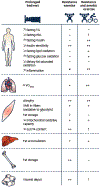Physiology of physical inactivity, sedentary behaviours and non-exercise activity: insights from the space bedrest model
- PMID: 33501660
- PMCID: PMC10895929
- DOI: 10.1113/JP281064
Physiology of physical inactivity, sedentary behaviours and non-exercise activity: insights from the space bedrest model
Abstract
Physical inactivity, i.e. not reaching the recommended level of physical activity (PA), and sedentary behaviours (SB), i.e. sitting time, have been associated with increased risk for common metabolic diseases. Recent epidemiological data suggest that high volumes of SB are detrimental to metabolic health, even in the presence of regular exercise, i.e. moderate/vigorous PA. This suggests that the health effects of SB are independent from those of exercise. However, experimentally testing this hypothesis is complicated because of the difficulty in disassociating SB from PA. Bedrest studies, a traditional space science model, can offer new insights. In some bedrest studies, an exercise training protocol has been used to counteract the harmful effects of inactivity. While bedrest induces an inactive and sedentary state, exercise with bedrest represents a unique model of sedentary yet physically active people. Here, we review bedrest studies with and without exercise training. Although exercise training prevents the loss of muscle mass and function, even large volumes of exercise are not sufficient to fully counteract the negative metabolic adaptations triggered by inactivity. This observation supports the existence of independent adverse health effects of SB, but also the potential benefits of non-exercise activity, i.e. daily living light PA. We gathered available data to examine the complex relationships between exercise, non-exercise activity, SB and health outcomes. Given the large amount of SB in modern societies, the sole promotion of exercise, i.e. moderate/vigorous PA may be insufficient, and promotion of light PA may be a complimentary approach to improve health.
Keywords: bedrest; exercise; light physical activity; metabolism; moderate to vigorous physical activity; non-exercise activity; physical inactivity.
© 2021 The Authors. The Journal of Physiology © 2021 The Physiological Society.
Conflict of interest statement
Conflict of interest
No conflict of interest to declare.
Figures


References
-
- Alibegovic AC, Højbjerre L, Sonne MP, van Hall G, Alsted TJ, Kiens B, Stallknecht B, Dela F & Vaag A. (2010a). Increased rate of whole body lipolysis before and after 9 days of bed rest in healthy young men born with low birth weight. American Journal of Physiology Endocrinology and Metabolism 298, E555–564. - PubMed
-
- Alibegovic AC, Højbjerre L, Sonne MP, van Hall G, Stallknecht B, Dela F & Vaag A. (2009). Impact of 9 days of bed rest on hepatic and peripheral insulin action, insulin secretion, and whole-body lipolysis in healthy young male offspring of patients with type 2 diabetes. Diabetes 58, 2749–2756. - PMC - PubMed
-
- Alibegovic AC, Sonne MP, Højbjerre L, Bork-Jensen J, Jacobsen S, Nilsson E, Faerch K, Hiscock N, Mortensen B, Friedrichsen M, Stallknecht B, Dela F & Vaag A. (2010b). Insulin resistance induced by physical inactivity is associated with multiple transcriptional changes in skeletal muscle in young men. American Journal of Physiology Endocrinology and Metabolism 299, E752–763. - PubMed
-
- Amagasa S, Machida M, Fukushima N, Kikuchi H, Takamiya T, Odagiri Y & Inoue S. (2018). Is objectively measured light-intensity physical activity associated with health outcomes after adjustment for moderate-to-vigorous physical activity in adults? A systematic review. The International Journal of Behavioral Nutrition and Physical Activity 15, 65. - PMC - PubMed
-
- Bailey DP & Locke CD. (2015). Breaking up prolonged sitting with light-intensity walking improves postprandial glycemia, but breaking up sitting with standing does not. Journal of science and medicine in sport 18, 294–298. - PubMed
Publication types
MeSH terms
Grants and funding
LinkOut - more resources
Full Text Sources
Other Literature Sources
Medical

